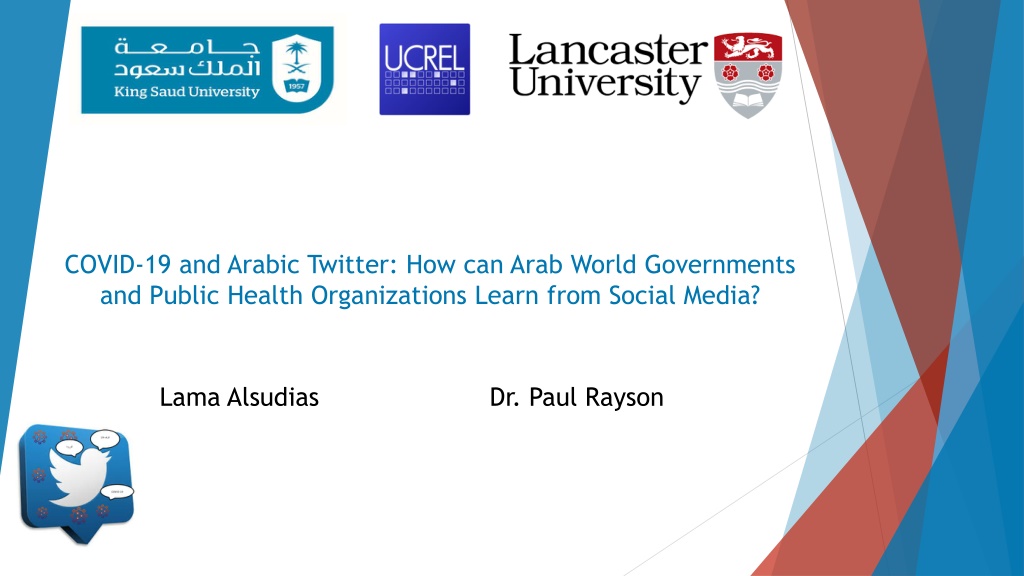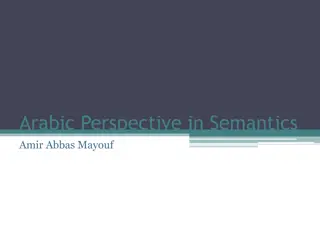Leveraging Arabic Twitter for COVID-19 Insights
Governments and Public Health Organizations can harness the power of Arabic Twitter to extract valuable insights during the COVID-19 pandemic. By analyzing Arabic tweets, they can uncover topics of discussion, identify rumors, predict tweet sources, and update disease ontologies. Data collection spanned from December 2019 to April 2020, gathering six million Arabic tweets related to COVID-19. Pre-processing steps involved filtering out noise and normalizing tweets for analysis.
Download Presentation

Please find below an Image/Link to download the presentation.
The content on the website is provided AS IS for your information and personal use only. It may not be sold, licensed, or shared on other websites without obtaining consent from the author.If you encounter any issues during the download, it is possible that the publisher has removed the file from their server.
You are allowed to download the files provided on this website for personal or commercial use, subject to the condition that they are used lawfully. All files are the property of their respective owners.
The content on the website is provided AS IS for your information and personal use only. It may not be sold, licensed, or shared on other websites without obtaining consent from the author.
E N D
Presentation Transcript
COVID-19 and Arabic Twitter: How can Arab World Governments and Public Health Organizations Learn from Social Media? Lama Alsudias Dr. Paul Rayson
Introduction Governments around the world have taken different decisions in order to stop the spread of COVID-19 . People use social media applications such as Twitter to find the news related to COVID-19 and/or express their opinions and feelings about it. We hypothesise that Governments and Public Health Organizations (PHOs) may benefit from mining the topics discussed between people during the pandemic. The Arabic language is spoken by 467 million people in the world and has more than 26 dialects1 . 1.https://en.wikipedia.org/wiki/Arabic
Introduction (Continued) In this paper, we have combined qualitative and quantitative studies to analyse Arabic tweets aiming to support Public Health Organizations who can learn from social media data along various lines: Analyzing the topics discussed between people during the peak of COVID-19. Identifying and detecting the rumours related to COVID-19. Predicting the type of sources of tweets about COVID-19.
Update Arabic Infectious Disease Ontology With the recent appearance of COVID-19 as a new disease, there is a need to update our Arabic Infectious Disease Ontology 2 , which integrates the scientific and medical vocabularies of infectious diseases with their informal equivalents used in general discourse. This included symptom, cause, prevention, infection, organ, treatment, diagnosis, place of the disease spread, and slang terms for COVID-19 and extended our ontology. These terms were then used in our collection process. 2. Lama Alsudias and Paul Rayson. 2020. Developing an Arabic Infectious Disease Ontology to Include Non-Standard Terminology. In Proceedings of The12th Language Resources and Evaluation Conference, pages 4844 4852, Marseille, France. European Language Resources Association
Data Collection When? We analysed the tweets related to COVID-19 from December 2019 to April 2020. How many? We have collected approximately six million tweets in Arabic during this period. What? We obtained the tweets depending on three keywords ( ), ( ) , and ( - 19 ) , which mean Coronavirus, a misspelling of the name of Coronavirus, and COVID-19 respectively in English. How? We collected the tweets weekly using Twitter API.
Data Pre-processing Filter out URLs, mentions, hashtags, numbers, emojis, repeating characters, and non-Arabic words using Python scripts. Manually remove retweets, advertisements, and spam. Normalize and tokenize tweets. Remove Arabic stopwords.
Dataset The resulting dataset was 1,048,576 unique tweets from the original 6,578,982 collected.
Methods We performed three different types of analysis on the collected data. To better understand the topics discussed in the corpus We carried out a cluster analysis We took a sample of the corpus, then classified the tweets To detect rumours To determine the veracity of the tweets. We extended our previous work to classify the source of tweets into five types of Twitter users
Cluster Analysis To explore the topics discussed on Twitter during the COVID-19 epidemic in Saudi Arabia and other countries in the Arab World, we subjected the text of the tweets to cluster analysis. After pre-processing the tweets as described above, we used the N-gram forms (unigram, bigram, and trigram) of twitter corpus. We clustered them using the K-means algorithm with the Python Scikit-learn software and set the value of k, the number of clusters, to be five.
Rumour Detection We applied a top-down strategy, which is where the set of rumours is identified in advance then the data is sampled to extract the posts associated with the previously identified rumours. In our dataset, out of the one million tweets, we sampled 2,000 tweets to classify them for rumour detection. We manually labelled the tweets to create a gold standard dataset and then applied different machine learning algorithms in this part of our study.
Labelling Guidelines Rumour in Arabic Rumour in English . . Pets are transporters of Coronavirus. Mosquitoes are transporters of Coronavirus. Children are not infected by Coronavirus. . Only old people may have a high risk of Coronavirus. Hot or cold weather can kill the virus. . . Gargling with water and salt eliminates the virus. There are some herbs that protect against from Coronavirus. . .
Example Tweets Tweet in Arabic . Tweet in English Label There will be a decrease in the spread of the Corona virus at the beginning of the summer, especially in the Arab world, due to the high temperatures. The Ministry of Health: A virus lives and is mainly concentrated in the respiratory system, so it is not likely to be transmitted by insects or by mosquito bites. Oh God, in this blessed hour, We ask you to have mercy on us and keep away from us all disease and calamity, and protect us from the evil of diseases and sicknesses. Preserve our country and other Muslim countries. 1 (false) : -1 (true) . . 0 (unrelated)
Machine Learning Models We applied three different machine learning algorithms: Logistic Regression (LR), Support Vector Classification (SVC), and Na ve Bayes (NB). To help the classifier distinguish between the classes more accurately, we extracted further linguistic features. The selected features fall into two groups: word frequency, count vector and TF-IDF, and word embedding based (Word2Vec and FastText). We used 10-fold cross validation to determine accuracy of the classifiers for this dataset, splitting the entire sample into 90% training and 10% testing for each fold.
Source Type Prediction We replicated a Logic Regression model from our previous study, which was useful for classifying tweets into five categories: academic, media, government, health professional, and public 3. We used this LR model because it previously achieved the best accuracy (77%), and employed it here to predict the source of the COVID-19 tweets that we had already labelled. 3. Lama Alsudias and Paul Rayson. 2019. Classifying in-formation sources in Arabic twitter to support monitoring of infectious diseases. In Proceedingsof the 3rd Workshop on Arabic Corpus Linguistics, pages 22 30, Cardiff, United Kingdom. Association for Computational Linguistics
Results and Discussion (Cluster Analysis) God, distract us from the epidemic, and grant us the evil of sickness with your kindness and mercy. You are capable of everything The Riyadh Municipality carries out purification and sterilization works for the main and secondary roads and establishments to prevent the spread of Corona : Ministry of Health: 15 new cases of recovery and 128 new cases of coronavirus were registered Statistics Prayers Locations .. .. Social spacing ... protection from corona ... stay in your homes Discount coupons for all major online stores Advising Advertising
Results and Discussion (Rumour Detection) Accuracy F1-score Recall Precision 84.03 83.71 82.24 81.04 80.03 80.5 72.59 75 65.97 60.73 60.68 58.08 49.96 49.75 48.08 47.9 COUNT VECTOR TF-IDF WORD2VEC FASTTEXT Figure: Results using Logistic Regression
Results and Discussion (Source Type Prediction) Tweet in Arabic Tweet in English Predicted Label Academic . ... In scientific reading ... the virus is expected to erode in April due to heat. Health spokesman has confirmed cases so far infected with coronavirus, mostly for adults. Ministry of health please spray mosquitoes, as they are carriers of the Coronavirus, increased infections as mosquitoes spread. A Chinese expert confirms that inhaling water vapor kills coronavirus. Corona treatment with lemon and garlic "YouTube link". . Media Government . . Health professional " Public ."
Conclusion In this paper, we identified and analysed one million tweets related to the COVID-19 pandemic in the Arabic language. We performed three experiments which we expect can help to develop methods of analysis suitable for helping Arab World Governments and Public Health Organisations. The clustered topics are COVID-19 statistics, prayers for God, COVID-19 locations, advise for preventing education, and advertising. Our second contribution is a labeled sample of tweets (2,000 out of 1 million) annotated for false information, correct information, and unrelated. Around 60% of the rumour related tweets are classified as written by health professional and academics which shows the urgent need to respond to such fake news.
Future work There are clearly many potential future directions related to analysing social media data on the topics of pandemics. Since false information has the potential to play a dangerous role in topics related to health, there is a need to enhance and automate the automatic detection process supporting different languages beyond just English. Future potential directions include monitoring the spread of the disease by finding the infected individuals, defining the infected locations, or observing people that do not apply self isolation rules. Moreover, the analysis could proceed in an exploratory and thematic way such as discovering further topics discussed during the epidemic, as well as assisting governments and public health organisations in measuring people's concerns resulting from the disease.
Thank You! If you have questions or feedback, please send to: l.alsudias@lancaster.ac.uk

 undefined
undefined





























